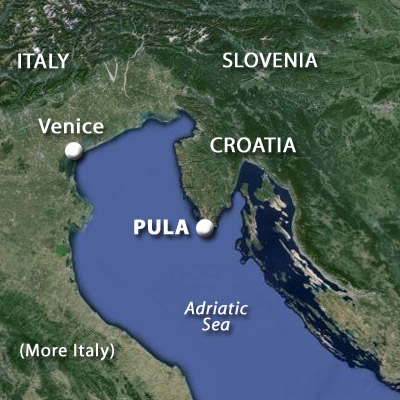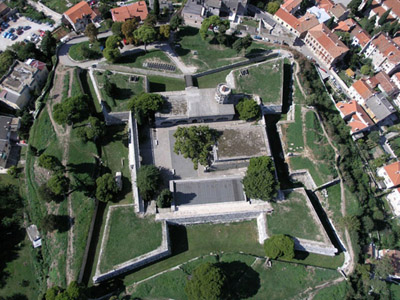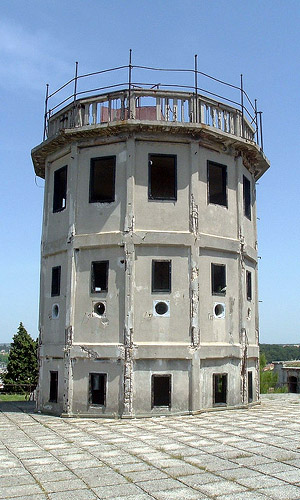 |
Pula Fortress
Pula, Croatia
|
|
 |
Venitian
Constructed:14th century, 1630
Used by: Republic of Venice,
Austria/Hungary,
France, Italy, Germany,
Yugoslavia, Croatia
Conflicts in which it participated: Many
|
Pula is in one of those parts of the world that just about every military power in history has tromped through. Except for the Zulus, who had engagements elsewhere.
Evidence of Homo erectus has been found in a cave near Pula, meaning that folks have lived in the region for over a million years. The Histrians were the first tribe to make a real settlement at Pula, and they built a hill fort where Pula Fortress now resides. |
 |
 |
|
Every time a new people took over Pula, that hill, overlooking the port and town, was recognized as the prime spot for fortification. Pula was an important Roman port around 45BC. The town unfortunately backed the wrong (losing) side in a Roman civil war, and was demolished in 42BC. Romans loved to build stuff, however, and in addition to applying their fortification expertise to the hill fort, the Romans built a lovely amphitheater, temples, gates and other impressive stuff that still classily litters the city today.
|
 |
 |
The Ostrogoths, Byzantine Empire, Franks and Pisians all took turns ruling Pula after the decline of Rome, until 1331, when the town swore allegiance to the Republic of Venice.
'Twas the Venetians who built Pula Castle on the hilltop in the 14th century, which was the structure that would become Pula Fortress.
During the Venetian period, Pula was attacked and occupied by the Genoese, Hungarians and Habsburgs, but they all eventually got bored and left. |
|
|
In 1630, Pula Castle became Pula Fortress, with the starfort upgrade that we've been waiting for. The Venetians hired French military engineer Antoine de Ville (1596-1656) to oversee improvements to a number of their fortifications, and it is de Ville's design expertise that we see in Pula Fortress' pointy corners.
|
The Most Serene Republic of Venice lasted 1100 less-than-serene years, finally concluding on October 14, 1797, with the Treaty of Campo Formio. This treaty was signed betwixt France and Austria, and divided the lands of the former Republic of Venice: Austria got Pula out of the deal and not much else.
And then it had even less than not much else, when France went ahead and took Pula for itself in 1805. The city was restored to the Austrian Empire in 1813, and it became Austria's main naval base and shipbuilding center over the next 100 years. Other than mounting more modern guns, the only Austrian addition to Pula Fortress was a kind of weird observation tower, which we see to the right.
The mighty Austro-Hungarian Navy's dreadnoughts were based at Pula during the First World War (1914-1918), which Austria-Hungary lost so comprehensively that it ceased to exist in 1918. Pula became part of Italy as a result.
When Italy was knocked out of the Second World War (1939-1945) in 1943, Nazi Germany moved into Pula, whose shipyards were used as a U-Boat base. This naturally led to the city being bombed by the Allies, but somehow Pula Fortress made it through the war unscathed...maybe because a 17th century fort wasn't considered an active military threat at the time.
|
 |
 The rusting observation tower at Pula Fortress. A recent visitor from the UK climbed this rickety tower and reported that he was "absolutely certain that you would not be allowed to do that in England." |
|
|
Pula became part of Yugoslavia in 1947, and then Croatia in 1991. Since 1961 the Istria (the province in which Pula lies) Historical Museum has been housed at Pula Fortress. Today there is also a maritime museum at the fortress, featuring such fascinating exhibits as a jar of a ship's surgeon's dried semen. Which will set off an alarm if you pick it up, so you'll have to resist your natural urge to fondle it.
|
A collection of guns of the many nations that have armed Pula Fortress over 700 years, beneath an unnaturally blue sky. |
|
|
|
|
|
|
 |


